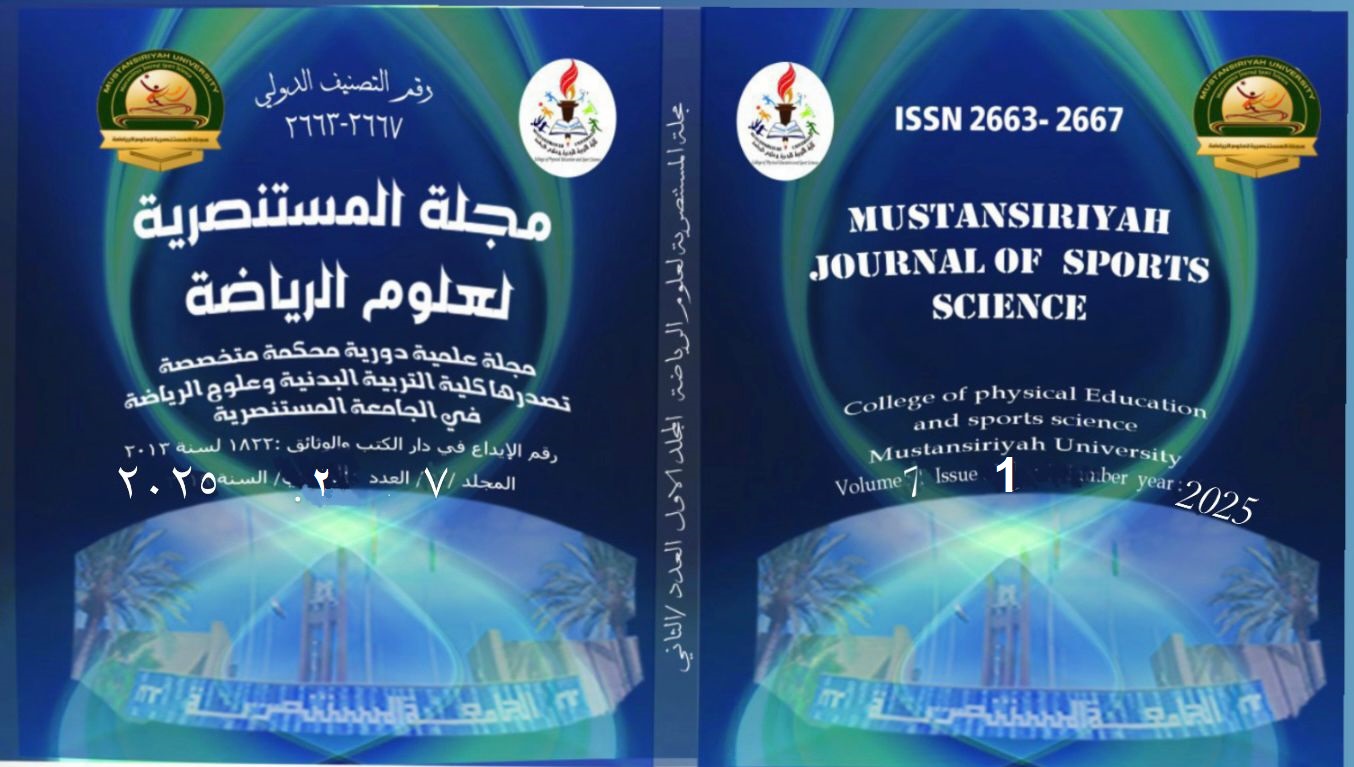The Effect of Multiple-height Hurdles with Continuous Repetition on Developing some Aspects of Leg Muscle Strength and the Digital Level of the 100m Race
Main Article Content
Abstract
The research aims at recognizing the impact of multiple-height barriers by continuously replicating the development of certain muscle strengths of the two men and the digital level of the 100m race in an effort by researchers to reduce the problem of the weakness or stability of the numbers achieved by the college players and contribute to find a scientific solution to them by identifying the causes of that weakness. In order to apply the research procedures, researchers selected the sample of research in a deliberate manner from the players of the Faculty of Physical Education and Sports Sciences team of the University of Anbar for a race run of 100 m (7) runners during the academic year (2024/2025), (1) runner was excluded because wasn’t being regular in the trial due to injury and thus the number of sample personnel (6) players. The main conclusions reached are that the proposed exercises using multi-height barriers with continuous repetition have a positive effect on the development of most of the muscle strengths of the two men (in question) and the digital level of 100m running runners (search sample personnel), as well as that the muscle strength of the two men has an effect on the length of the hostility step and its frequency rate, which is reflected in its speed.
Downloads
Article Details

This work is licensed under a Creative Commons Attribution-NonCommercial 4.0 International License.
References
Abdel Hamid, K., & Hassan, M. S. (1997). Foundations of Sports Training to Develop Physical Fitness in Physical Education Classes in Boys’ and Girls’ Schools (p. 127). Dar Al Fikr Al Arabi.
Abu Al-Ala, A. A. F., & Haitham, A. H. D. (2019). Training for Sports Performance and Health (p. 518). Dar Al-Fikr Al-Arabi.
Ahmed, M. S. A., Yousef, K. D., & Raghad, K. R. (2024). The effect of strength exercises characterized by speed on some physical abilities and the achievement of the (100) meter race for juniors. Wasit Journal of Sports Sciences, 18(1), 127–142. https://doi.org/10.31185/wjoss.432
Alawi, O. H., & Ahmed, F. A. J. (2024). The effect of intensive lactic training on specific endurance and 200m running performance in young men. Al-Mustansiriya Journal of Sports Sciences, 6(4), 172–182. https://doi.org/DOI:https://doi.org/10.62540/mjss.2024.4.6.12
Al-Basati, A. (2016). Training and functional physical preparation in football (p. 105). Maaref Establishment.
Al-Basati, A. A. A. (2015). Sports Training “Theories and Applications (p. 17). King Saud University Publishing House.
Ali, A. N. (2021). The Effect of Psychological Program of some Relaxation Exercises and Mental Visualization on the Achievement of Player Runners (400). Journal Mustansiriyah of Sports Science, 3(3).
Allawi, M. H., & Radwan, M. N. al-D. (1994). Motor Performance Tests (3rd edition). Dar Al-Fikr Al-Arabi.
Bastawisi, A. (1999). Foundations and theories of sports training (p. 30). Dar Al-Fikr Al-Arabi.
Hamad, S. H., Abdul Rahman, M. A. Q., & Mukhalaf, A. K. (2023). The effect of (auditory-visual) exercises on developing agility and motor response to the blocking wall skill in volleyball. Mustansiriyah Journal of Sports Science, 5(3), 184–197. https://doi.org/https://doi.org/10.62540/mjss.2023.05.03.15
Hassan, A., Muaya, N., & Alshammaa, H. (2022). The Effect of Harmonic Training Based on a Rubber Rope Network on the Instantaneous Strength, Maximum Speed Stage and Achievement for the Effectiveness of Running 100m for Young Women. Journal Mustansiriyah of Sports Science, 4(1).
Hassanein, M. S., & Ahmed, K. M. (1998). Encyclopedia of Applied Sports Training (1st ed, p. 76). Book Center for Publishing.
Hazem, A. T. A. R. (2022). Track Competition Training between Scientific Theories and Practical Applications. Dar Al-Wafa for Dunya Printing.
Ibrahim, I. M. (2018). Theoretical and practical foundations for field and track competitions. Education-Technique-Training-Law”, Kitab Publishing Center.
Ihab, F. M., & Jaber, B. (2004). Cross-training (Basics/Concepts/Applications) (p. 160). Maaref Establishment.
Khairiya, I. A.-S., & Muhammad, J. B. (2015). Speed training programs, transitional speed, agility and balance (Part One, p. 36). Maaref Establishment.
Malik, O. M. (2021). The effectiveness of aerobic exercises using rubber bands on some of physical fitness elements for secondary school students. Al-Mustansiriya Journal of Sports Sciences, 3(1), 202–210. https://doi.org/DOI:https://doi.org/10.62540/mjss.2021.03.01.21
Mohamed, A.-G. O. (2018). Training and Sports Medicine (Part One, p. 568). Book Center for Publishing.
Mohamed, A.-G. O. (2019). Training and Sports Medicine (Part Two, p. 110). Maaref Establishment.
Muhammad, H. A. (1994). Sports Training Science (13th edition, p. 152). Dar Al-Maaref for Printing and Publishing.
Schiffer, J. (2011). Training to overcome the speed plateau. New Studies in Athletics, 26(1/2), 7–16.
Walihi, J. (2017). Study of the relationship between some morphological factors and the strength characterized by speed using plyometric training among football players, middle category, 17-19 years old. The Challenge, 9(1), 11–34.
Zaher, A. R. (2024). Energy Production Systems and Sports Training (p. 91). Book Center for

